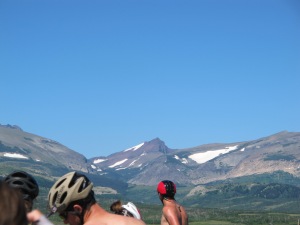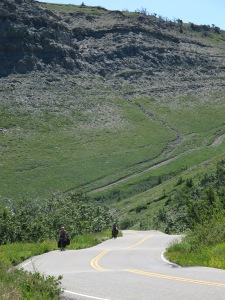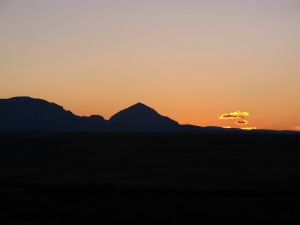
Our two wheeled trek across the vast stretches of central Montana, and northward bound up The Rocky Mountain Front, eventually taking us into the belly of the beast that is the Crown of the Continent ecosystem, including the mythic Glacier National Park, was about gaining a more comprehensive and insightful perspective on the complex interrelations of energy systems and climate change in Montana. We have talked to people connected to these issues in some way or another, from all sides of the equation, and there are no clear answers except one: If we keep burning coal (or selling it to burn elsewhere) we might as well not even try.
Coal is the large, dirty, and toxic elephant in the room. Even if everyone in America went totally light green and started doing all the simple living tactics we would only drop overall carbon emissions by 20 percent. Scientific consensus suggests that emissions must be reduced by 80% percent to stop catastrophic runaway climate change. Coal produces upwards of 60% percent of total carbon emissions. And carbon trapped in the form of coal underground is an important aspect of the overall carbon cycle that contributes to our current climate paradigm; putting that coal into the system that has been out of the equation for millions of years can (and does) throw off the balance.

An over simplified explanation of the end-Permian mass extinction event, which happens to be the largest die off of life on earth known to man, was caused by massive changes in ocean chemical content. Increases in atmospheric carbon just so happens to lead to changes in in the chemical composition of our oceans. Carbon dissolves in water to form carbonic acid, this has contributed to a lowering of the overall pH of the ocean systems. This, to me, is the most important aspect of releasing vast amounts of carbon in a relatively short amount of time. As a scuba diver, I have seen close up how intricate and beautiful our coral reefs are. Slight changes in pH levels can drastically harm these delicate systems. If the oceans collapse our species collapses along with most of known life on earth.
We have just looked at some of the macro level environmental concerns of coal. Let us examine the micro level environmental and social concerns regarding coal burning and coal exports in particular. What are the externalities of coal extraction? According to the Energy Information Administration, 43.2 percent of coal extraction comes from public lands. The largest coal reserve in the country, the Powder River Basin in Wyoming and Montana, is conveniently not classified as a “coal producing region” which leads to a shortchange to taxpayers when the land is not competitively leased for mineral extraction. Another environmental concern is the direct impact to land bases, rivers, and aquifers. Of the 37,500 acres of Montana’s land decimated by strip mining only 50 acres have been reclaimed. You cannot rebuild an aquifer; once it is gone, it is gone forever.
Another factor to think about while you’re sitting in your car waiting for the projected triple fold increase in coal train traffic coming through your city is the amount of toxic coal dust that is lost during transportation. Estimates show that around 500 pounds per train car, adding up to 30 tons per train, is lost en route to the west coast. Mercury, cadmium, and a whole host of harmful elements are present in that dust.
We have met with people who are connected to the coal industry and leaders of communities who rely on coal. I understand there is a complex interrelation and hard cost of stopping coal extraction. However, I feel that coal is an outdated and overall harmful method of producing electricity. Leave the ranchers alone and let them produce food, which is more important than dirty and inefficient energy. A handful of people pocket the profits, Asia will receive most of the energy, and you and I are left with the bill.
